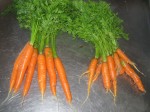The Great Carrot Trial
 The carrots in your box this week are the result of an experiment. No, they are not genetically modified or altered in any way—Mokum is a sweet, tender, relatively early variety in the Nantes class. They have, however, been grown in a field that was treated with mustard seed meal (the solids that are left after mustard seeds have been pressed for oil).
The carrots in your box this week are the result of an experiment. No, they are not genetically modified or altered in any way—Mokum is a sweet, tender, relatively early variety in the Nantes class. They have, however, been grown in a field that was treated with mustard seed meal (the solids that are left after mustard seeds have been pressed for oil).
When we first purchased our new farm in North Monterey County, one of the things I was most excited about was the possibility of being able to grow carrots other than Red Cored Chantenay, which is the only type that grows well in our heavy soils. It’s not that I dislike Chantenay carrots; in fact, I love them. They are a great all-around carrot with good flavor and sweetness. It’s just that there is a wide world of carrots out there (white, yellow, red, purple and all the varieties in the Nantes family) that wasn’t really open to us.
So as soon as the ground became dry enough to work at our new site, one of the first things I planted was a large block of Mokum carrots. As a standard practice, I will pluck out a few carrots a various stages just to see how the tap roots are developing. And with this block it became evident at an early stage that something was wrong. Instead of developing a clean, straight tap root, about half of the carrots were forked out shallowly like the roots of a tree. The other half had tap roots that where pinched and forked about 3-4 inches down. All of the carrots had little white “galls” on them. When I looked it up in one of my pest management books, it was obviously a bad case of root-knot nematodes—something I had never had to deal with before.
Considering that the field had been fallow for over two decades, it was amazing to me that these pests had remained in the soil. The only explanation that I have come up with is that one of the weeds that predominated during the fallow period must have acted as a host. Because there are few viable organic management strategies, I became resigned to the depressing thought that we would just have to focus on less susceptible crops there.
Then one morning as I was leafing through the Ag-Alert, The Farm Bureau’s weekly paper, I came across a picture of a nematode infested carrot that looked exactly like ours. The accompanying article was about an experiment performed at UC Riverside, that looked into ways of controlling root-knot nematodes. In addition to trialing several conventional nematodices, the researchers decided to include a couple of organic treatments as well—a mustard cover crop, and the application of mustard seed meal. They were surprised to find out that at the medium application rate, not only did the mustard meal work, it worked nearly as well as the conventional chemicals did—something that is nearly unheard of with organic treatments.
As if turns out, I am familiar with mustard seed cake through doing trials with the folks at UC Santa Cruz on our strawberries for soil borne disease control. It also turns out that a small company called Farm Fuel sprang up here in Watsonville a few years back and is pressing mustard seeds for both oil (to use for biofuel) and seed cake as an organic fertilizer. Mustard grows easily in California’s climate (you’ve probably seen fields of wild mustard plants with their pretty yellow flowers growing in orchards or on buffer strips around farms) and it can be grown in a resource-efficient way on fallow fields or in rotation with other crops, so it seems like a real winner all around. I hastily ordered enough seed meal for a quarter acre and went about setting up a trial in the very same field that we had the earlier problems with. After the trial beds were listed up I spread the mustard meal on top, and then worked it in with a rototiller to a depth of about 8 inches. We soaked the field with sprinklers to activate the mustard and then waited for two weeks before planting. When it begins to break down, mustard seed cake also releases a natural compound that suppresses certain soil borne pests and diseases.
When I set up the trial I knew that to be meaningful, I would have to include an untreated control—which I did. I planted one row of carrots in ground that was not treated with the mustard seed meal. As I monitored the field’s progress by periodically plucking out test carrots, I was cautiously optimistic. And by the time the carrots reached maturity I was ecstatic. The difference between the treated and untreated carrots is dramatic to say the least.
From cooperating with researchers on various projects over the years I know that results this clear cut are rare indeed. But as any good scientist with tell you, to be truly meaningful, repetition is key. And you can bet this is one experiment that we are going to repeat—every time we plant carrots.
Search High Ground Site
High Ground Favorites Cloud
apples arugula basil beets braise broccoli carrots cauliflower celery chard cheese cilantro dressing fennel fish herbs kale leeks lemon lettuce Meyer lemon mint mushrooms nuts onions oregano parsley peppers pork potatoes quickles radishes salad sauce saute scallions soup strawberries summer squash tomatoes topping vegan vegetarian vinaigrette winter squash



